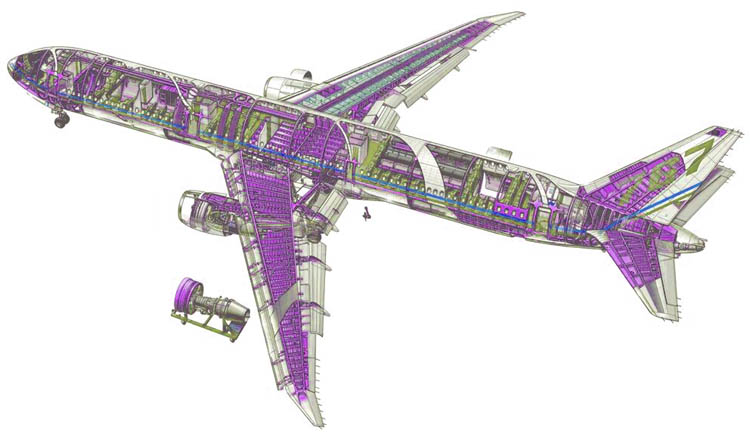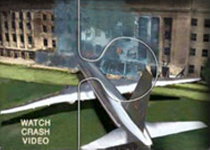This page is an overview of the structural requirements and solutions in the recent history of aircraft design. The page is meant as a simple guide to understanding the basics of aeronautic structural design and the corresponding forces placed on different parts of the aircraft. It is difficult, if not impossible, to enter into a discussion or analysis of airframe collisions without understanding the basics of airframe construction. An airplane cannot be considered a rigid object of familiar shape. Nor can it be considered something totally collapsible – but somewhere in between. By paying close attention to the larger structural components of an airframe, we come to a more accurate understanding of aircraft collisions. In the situation where we have a collision with a solid structure – some parts of the aircraft are far more likely to collapse and others to remain strong. For example – the more familiar one is with aeronautic structures – the more one realizes how improbable the possibility of wings ‘folding up’ actually is. It may be consistent with a vision of the world as plastic injection molded shapes – but in fact has very little to do with the construction of airplanes.
Of course, aircraft designed for different purposes (the McDonnell Douglas F15A fighter jet, the Boeing 757 passenger airliner, the two seat Beachcraft Bonanza and others) will offer wildly different design solutions – depending on the requirements. While the details of the designs my vary wildly, the basic principles that go into it’s construction are constant. One can never be reminded enough that the laws of physics are blind and do not change according to application.
 |
|
 |
|
|
Structural Design Solutions for Two Airframes: A Case Study

|
|
| |
|
|
| |
above: Structural view of Boeing 767 (nearly identical structurally to 757) showing primary and secondary structural elements (in purple). Supporting elements to main spar cage seen in wing, creating the overall stiffness required for the large structural loads demanded upon the 757’s wing – the stiffness to weight ratio of the final structure must successfully transfer the 300 plus ton load placed on the wings. Due to the dynamically changing environment (due to winds and possible aerobatic manoeuvers) the wing structure (main spars) must be designed for up to ten times the nominal design load.
|
|
| |

Structural illustration of a McDonnell-Douglas F-15. Note the increased complexity of stiffening components (mostly lightweight alloys of aluminum and titanium where necessary). A fighter jet like the F15, capable of far higher speeds and far more extreme manoeuverability than the commercial jetliner requires a higher strength/stiffness to weight ratio or else it would disintegrate in mid-air.
|
|
| |
Photographs of layup of a 757 main wing spar at Boeing, Inc. The main wing spar is one of the most critical load bearing components of any winged aircraft. It is the main spar which must transfer the net lift (can be many times the weight of the plane) through the rest of the structure.

Modern aircraft structures are designed using a semi-monocoque concept- a basic load-carrying shell reinforced by frames and longerons in the bodies, and a skin-stringer construction supported by spars and ribs in the surfaces.
The calculation of proper stress levels, a very complex problem in highly redundant structures, are calculated using versatile computer matrix methods to solve for detailed internal loads. Modern finite element models of aircraft components include tens-of-thousands of degrees-of-freedom and are used to determine the required skin thicknesses to avoid excessive stress levels, deflections, strains, or buckling. The goals of detailed design are to reduce or eliminate stress concentrations, residual stresses, fretting corrosion, hidden undetectable cracks, or single failure causing component failure. Open sections, such as Z or J sections, are used to permit inspection of stringers and avoid moisture accumulation.
Fail-safe design is achieved through material selection, proper stress levels, and multiple load path structural arrangements which maintain high strength in the presence of a crack or damage. Examples of the latter are:
a) Use of tear-stoppers
b) Spanwise wing and stabilizer skin splices
|
|
 |
|
 |
REFERENCES:
Aircraft Design: Synthesis and Analysis
Aircraft Structural Design
Aircraft Stress Analysis and Structural Design
Wikipedia’s Page on Aircraft Design Process
The Structural Design of Airframes (PDF)
The FAA’s Pilot’s Handbook: Chapter2 – Aircraft Structure (PDF)
|




 List of Members
Log in
List of Members
Log in